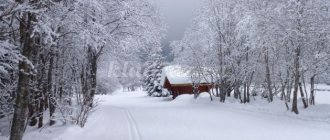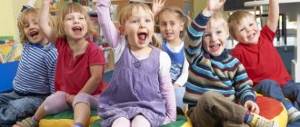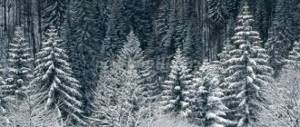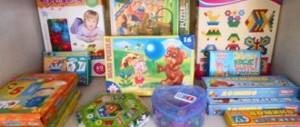Author's game “Geese-Swans” (Russian folk outdoor game: “Geese-Swans” processed)
MAUDO "Kindergarten No. 8", Tyumen region. Yalutorovsk
Physical education instructor in kindergarten
Link to the article, when indicated in the bibliography (according to GOST R 7.0.5–2008):
Levshina A.G. Author's game “Geese-swans” (Russian folk outdoor game: “Geese-swans” processed) // Sovushka. 2016.№1. URL: https://kssovushka.ru/e-sovushka.2016.n1-a/ZP15120028.html (access date: 10.10.2020).
Section 1
Source : Children's outdoor games of the peoples of the USSR: manual. M.: Education, 1988.
Russian folk outdoor game: “Geese - Swans”
Goal : To teach children to pronounce words clearly. Practice agility and reaction speed. Rules : Until the children say all the words, the game does not begin. The geese should “fly” all over the site. The wolf can catch them only after saying: “You fly as you want, just take care of your wings!”
Progress of the game: Participants in the game choose a wolf and an owner with a counting rhyme, the rest of the children choose “geese - swans”. On one side of the hall there is a house where the owner and geese live, on the other there is a wolf living under the mountain. The owner lets the geese out into the field to take a walk and browse some green grass. Geese go quite far from home. After some time, the owner calls the geese. There is a roll call between the owner and the geese: Owner : Geese - geese! Geese : Ha - ha - ha. Owner : Do you want anything? Geese: yes, yes, yes. Owner : so fly home. Geese : The gray wolf under the mountain does not let us go home. Owner : You fly as you wish, just take care of your wings! The geese are running into the house, the wolf is trying to catch them (the children are running all over the hall). Caught geese leave the game. The game ends when almost all the geese are caught. The last remaining goose, the most agile and fastest, becomes a wolf.
Section: 2
Russian folk outdoor game: “Geese-swans” First option
Goal : To teach children to pronounce words clearly. Develop attention and coordination of movements. Practice agility and reaction speed. Rules of the game : After the words “Be careful when you walk and avoid the wolf!” children must run from one hoop to another; the child (the wolf) tries to catch those who did not manage to run into the hoop. Until the words are spoken, the wolf must not catch the children. Material: There are more hoops than children, wolf and geese masks, a scarf. Progress of the game: The participants of the game choose the wolf and the owner (whoever jumps further is the driver), the rest of the children are “geese-swans” The wolf stands in the middle of the hall. Hoops are laid out throughout the hall - these are the houses of geese. The owner lets the geese out into the field to take a walk and browse the grass. After some time, the owner calls the geese. At this time, the geese managed to hide in the houses. A roll call began between the owner and the geese. Owner: Geese, geese. Geese: Ga-ha-ha. Owner: Do you want something to eat? Geese: No, no, no. Owner: You can take another walk, just don’t break your wings! Geese: The gray wolf is guarding us and doesn’t let us go for walks. Owner: Walk carefully and avoid the wolf! After the owner’s words, the geese begin to fly from one house to another. The wolf must catch the goose that did not have time to fly into the house. A caught goose is eliminated from the game. The game ends when the wolf catches 8-10 geese. This version of the game is especially useful for children with disabilities. The next drivers are chosen like this: whoever jumps the highest.
Russian folk outdoor game: “Geese-swans” Second option
Goal : To teach children to pronounce words clearly. Develop attention, coordination of movements, orientation in space. Practice agility and reaction speed. Rules of the game : On one side of the hall there are geese (children) and the owner (child). There is a wolf (child) standing in the middle of the hall. Children (geese) must run from one side of the hall to the other several times back and forth, without stepping into the wolf's area (the wolf is limited by ropes). A child (wolf) catches children (geese), moving only to the right and left, turning around himself in his pre-prepared zone. Until the words are spoken, the game does not begin and the wolf must not catch the geese (children). Material : Two ropes. Wolf and geese masks, scarf. Progress of the game. Participants in the game choose a wolf and an owner. Whoever can jump on one leg the longest is the driver, the rest of the children are geese. The geese and their owner stand on one side of the hall. The wolf stands in the center of the hall, we lay out a limit for him from the ropes - this is his strip of forest in which he lives. The owner lets the geese out for a walk to stretch their wings. Geese fly all over the hall, flying into the forest to the wolf. The owner calls the geese home. Owner : Geese, geese! Geese : Ga-ga-ga. Owner : Are you tired? Geese: Yes, yes, yes. Owner : So fly home, I’ll feed you food. Geese : The wolf guards his forest and doesn’t allow us passage! Owner : Flap your wings strongly, fly over the evil wolf. Geese fly (jump over) the line of the forest in which the wolf lives; they should not get into the wolf’s teeth. The wolf moves through his forest left and right, turning around his axis, trying to catch the geese. Geese can fly from one side of the hall to the other several times. A caught goose is eliminated from the game. The game ends when the wolf catches 10-12 geese. The next drivers are chosen as follows: whoever hits the ball off the floor the longest.
Russian folk outdoor game: “Geese-swans” Third option
Goal: To teach children to pronounce words clearly and respond to the teacher’s signal. Develop attention and coordination of movements. Practice agility and reaction speed. Rules: Children, in the role of a wolf and geese, stand on opposite sides of the hall; these are their houses. The teacher lets the children run around the hall. At the signal (whistle, tambourine, clapping), children run to their place, and the wolf (child) must catch them. Children who are caught leave the game. Material : Whistle, wolf and geese masks, scarf. Progress of the game. Participants in the game choose a wolf and an owner. Whoever throws the ball or bag the farthest is the geese who leads the rest of the children. The wolf stands on one side of the hall, the geese with their owner are on the other side of the hall. The owner lets the geese fly. Geese fly all over the hall, the wolf watches them from his lair. The owner calls the geese. Owner : Geese, geese! Geese: ha-ha-ha. Owner: did you raid? Geese: yes, yes, yes. Owner: Fly home to the signal, don’t get caught by the evil wolf! Geese: We understand you, we are flying, we don’t want to meet the evil wolf! The geese fly around the hall as soon as they hear a signal (whistle, blows on a tambourine, etc.), the wolf begins to catch the geese, and they quickly fly to the owner. Caught geese are eliminated from the game. The game ends when the wolf catches 10-12 geese. The next drivers are chosen as follows: who will throw the ball or bag the furthest.
Preparing for the game
Regardless of the type of “Swans” you choose, the preparation for the entertainment is the same. First, mark all the locations of the game:
- House or farm
The owner lives here with the birds. The house is drawn on one side of the field. You can mark it with chalk or draw a line on the ground with a stick. If the entertainment takes place on the grass, then the corners of the house are marked with four stones.
- Pasture
A place where goslings go for a walk. The pasture is located at the other end of the field, opposite the house. You can also mark the boundaries of the swan meadow with chalk, a line or stones.
- Wolf's Lair
What else to read Outdoor games with basketball elements: types and results
Habitat of the main enemy goslings. The den is located on the edge of the play area about ten steps from the pasture. The designations for wolf mountain are the same as for a house or meadow.
Having indicated all the significant places on the field, it’s time to move on to the distribution of roles. To do this, you can use an ordinary counting rhyme or come up with your own way. For example, the one who throws the ball the farthest will be the wolf, and the one who jumps the farthest will be the owner. The rest of the guys become birds.
Remember that the more swans play, the more predators there should be. The owner of swan geese is often a teacher or one of the parents who ensures that the rules of the game are followed.
Option with hoops
The game “Geese and Swans” in kindergarten is usually played with hoops. This variation helps the child develop dexterity and reaction.
What else to read Pioneerball: rules and game options
The rules are different: this time, in addition to the main places, hoops, or “goose houses,” are scattered in a chaotic manner on the playing field between the house and the pasture, and the gray one waits in the middle of the field.
Having distributed the roles, the dialogue begins again between the participants:
Farmer: Fly, geese, take a walk and nibble some grass!
The swans fly away into the field. A few minutes later, the conversation resumes.
Farmer: Geese, geese!
Feathered: Ha-ha-ha!
Farmer: Do you want to eat?
Feathered: No, no, no!
Farmer: Well, then you take a walk, but arrive before nightfall!
After this, the birds leave the pasture and occupy vacant houses.
Feathered: The gray wolf is no longer sleeping, and we have lost the sense of walking!
Farmer: So fly home, you will have peace at home!
When the owner utters the agreed phrase, the chicks begin to fly from one house to another, and the hunter, meanwhile, tries to grab them. The fun ends when a certain number of goslings have been caught.





